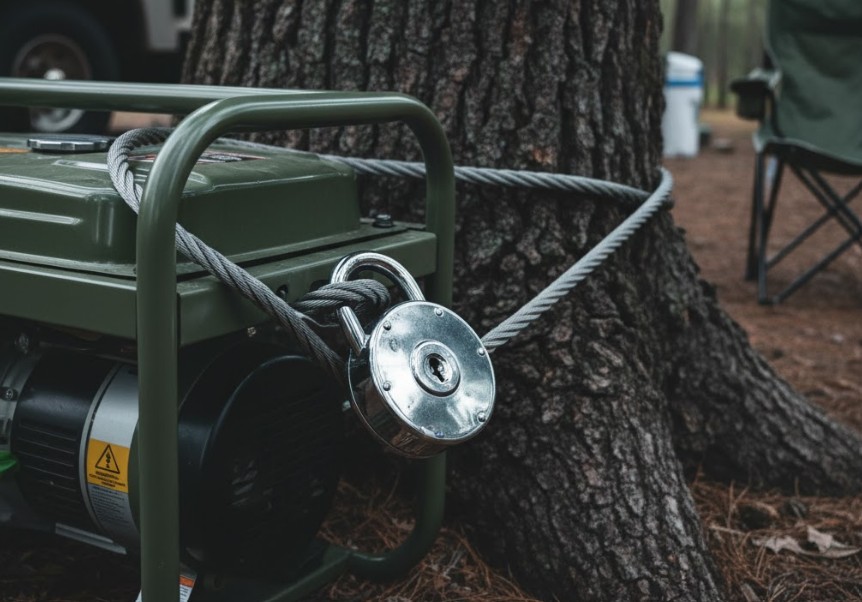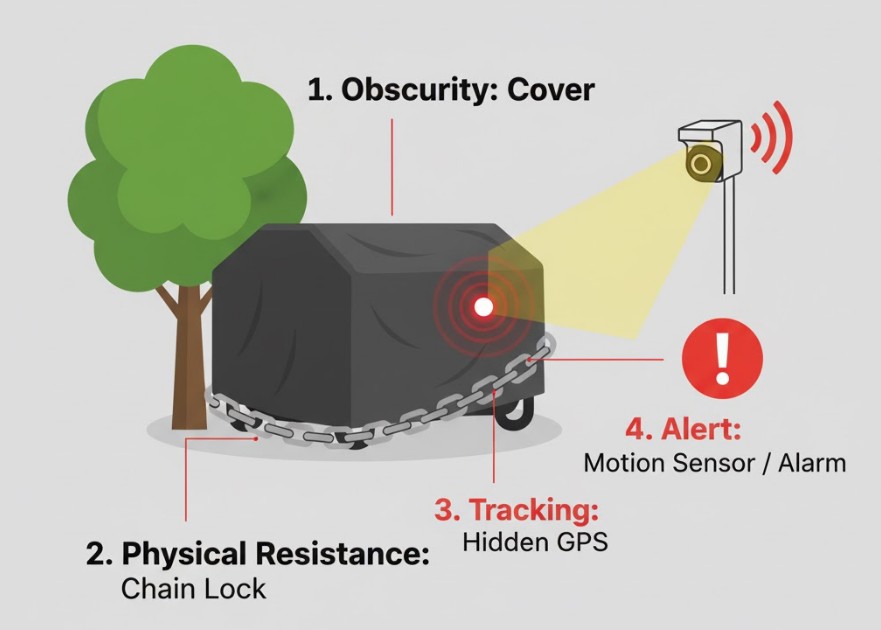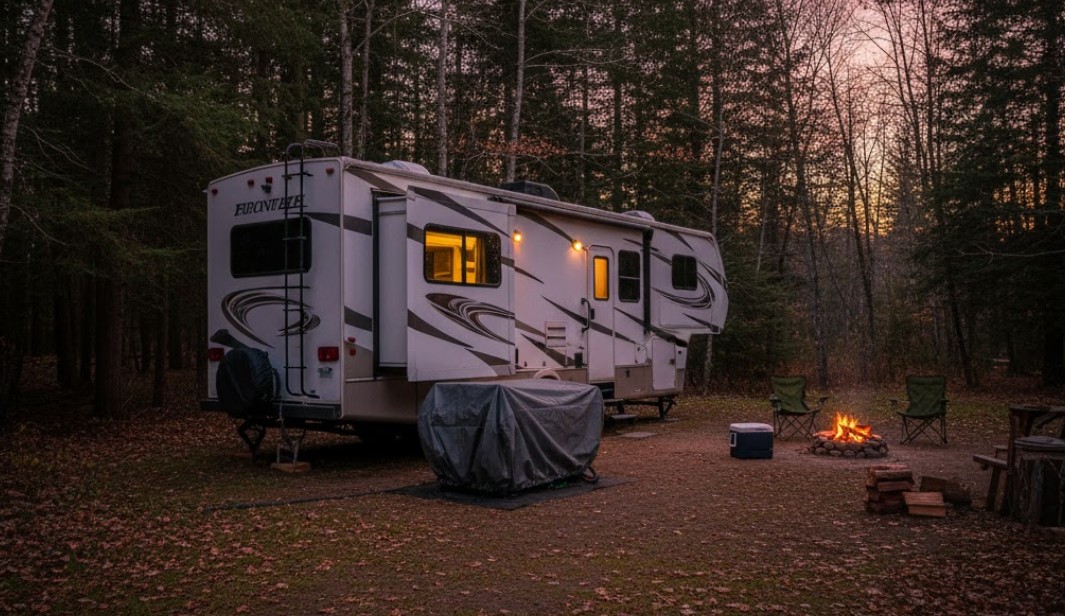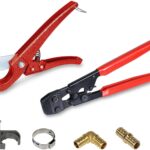Camping is one of life’s great pleasures. It’s a chance to unplug from the daily grind, breathe fresh air, and reconnect with nature. However, for many modern campers—especially those in RVs, running medical equipment, or just needing to charge devices—a generator is a necessity, not a luxury. While they provide essential power, their portability also makes them a prime target for theft. Therefore, knowing how to secure a generator while camping is just as vital as remembering your tent poles or propane.
This comprehensive guide will walk you through everything you need to know, from understanding the risks to employing advanced security strategies. We’ll delve into the best equipment, placement tips, and even the psychology of deterring potential thieves. Ultimately, our goal is to help you enjoy your trip with the peace of mind that your valuable power source is safe and sound. Furthermore, a well-secured generator is also a generator that is running safely, protecting both your investment and your family.
Understanding the Threat: Why Do Camp Generators Get Stolen?
Before diving into security solutions, it’s important to understand the motivation behind generator theft. It’s rarely a spur-of-the-moment decision. Thieves target generators for several simple reasons, all tied to the unit’s inherent value and ease of resale.
The High Value and Portability Factor
Modern inverter generators, particularly the quiet, compact models favored by campers (including best portable generators for camping), represent a significant investment. A quality generator can easily cost hundreds to thousands of dollars. The unfortunate reality is that a quick, illicit sale can net a thief a tidy profit. Consequently, the smaller, lighter, and more powerful the generator, the more appealing it is as a target. Thieves look for generators that are easy to grab and carry away, which is precisely what makes them so desirable for campers.
The Camp Environment: Opportunity and Isolation
Campsites, especially those in remote or dispersed areas, often offer a perfect blend of opportunity and low risk for criminals. Campers are frequently away from their site—hiking, fishing, or exploring—leaving their property unattended for long periods. Moreover, many campgrounds have minimal security presence, especially late at night when thefts are most likely to occur. The noise of a running generator might mask other sounds, but a quiet, sleeping campground can be a haven for undetected activity. This is why securing your best RV generators is a paramount concern for seasoned travelers.
Foundational Security: Placement, Visibility, and Deterrence
The first line of defense doesn’t involve heavy chains or locks; it involves smart choices about where and how you set up your camp.
Strategic Generator Placement
Where you place your generator is a critical first step in security. The ideal spot offers a balance between noise reduction and security access. Avoid placing your generator right next to the road or trail where it’s highly visible to passersby. Instead, position it closer to your RV or tent. This ensures that any attempt to tamper with it will be more likely to wake you or alert someone else.
- Close to Your Shelter: The closer it is, the less covert a thief can be.
- Out of Immediate Sight: While you shouldn’t bury it, you can place it behind a large bush, a water jug station, or other campsite elements to obstruct the view from the road.
- Near a Fixed, Immovable Object: This is crucial for the locking mechanisms we will discuss later. Think large trees, concrete picnic tables, or the frame of your RV if you’re using specialized security mounts.
The Power of Camouflage and Covers
An uncovered generator screams “valuable asset” to a potential thief. A simple, yet highly effective, deterrent is to use a high-quality generator cover. Not only do these covers protect your unit from rain, dust, and debris, but they also serve a fantastic security purpose: obscurity. Specifically, they obscure the make and model. A thief can’t quickly identify the brand and resale value if it’s hidden under a generic cover. When choosing your cover, look for one designed for security, such as those discussed with best generator covers. A muted, non-descript color is always better than a bright or branded one.
Lighting and Visibility
Criminals thrive in the dark. Good lighting can be a powerful deterrent. Consider setting up motion-activated lights facing the area where your generator is placed. Thus, if someone approaches the unit, the sudden burst of light will startle them and alert you to their presence. Even a small, solar-powered LED light that stays on all night near the generator is better than none. Keep in mind that your lighting choices should also be respectful of your fellow campers and dark-sky regulations, which is a consideration when choosing a how to pick best campsite.
Advanced Physical Security: Locks, Cables, and Anchors
When it comes to physical security, the goal is not to make the generator impossible to steal—anything can be defeated with enough time and tools—but to make it difficult, time-consuming, and noisy enough to make the thief look for an easier target.
The Essential Security Cable and Lock Setup
This is the workhorse of generator security. You need two main components:
- A High-Quality Cable or Chain: Do not rely on thin, vinyl-coated bike cables. Invest in a heavy-duty, hardened steel security chain or a thick braided steel cable. Look for cables with a diameter of at least 3/8 inch (10mm), or preferably thicker.
- A Robust Padlock: The lock is the weak point, so choose wisely. A laminated padlock is insufficient. Opt for a disc lock or a high-security shackle-less padlock. These designs expose less of the shackle, making them much harder to cut with bolt cutters.
Furthermore, the way you secure the cable matters immensely. Always run the cable through the solid metal frame of the generator, not a plastic handle or a wheel. Then, secure the other end to an immovable object, such as a large, healthy tree (check park rules first), a concrete picnic table, or a specialized anchor point you’ve installed on your RV or vehicle.
DIY Anchor Points and Ground Anchors
What if there isn’t a convenient tree or table? This is where professional-grade anchor points come in, especially useful for those with best solar generators for off grid living or semi-permanent setups. For instance, specialized security companies make ground anchors that you can screw or hammer into the earth. These are essentially heavy-duty stakes with a lockable loop on top. Additionally, for RV owners, mounting an anchor directly to the trailer frame (often under the chassis) provides a hidden and rock-solid point to secure the cable.

Specialized Generator Security Kits
Several companies manufacture generator-specific security kits that include a steel enclosure or a security bar. These systems are custom-designed to fit around the unit, making it nearly impossible to access the frame for cutting. They often come with tamper-proof bolts and high-security locks. While more expensive than a simple cable, they provide an extremely high level of protection, particularly for premium inverter generators.
Integrated Security: RV and Vehicle-Based Solutions
When you are camping with an RV or a travel trailer, you have more options for securing your power source. These solutions often leverage the weight and immobility of your vehicle to enhance security.
Generator Trays and Cargo Carriers
Mounting your generator on a rear-mounted hitch cargo carrier or a specialized RV bumper tray is a common practice. If you use this method, you can pass a security chain through the generator frame and around the heavy-duty steel hitch receiver. This is a far more secure anchor point than a wooden picnic table and is less prone to park regulations concerning chaining to trees. However, ensure the cargo carrier itself is secured to the hitch with a high-quality, locking hitch pin to prevent the entire assembly from being removed.
The Lock-and-Strap Method for RVs
Many RV owners use a simple yet clever technique: they place the generator close to one of the RV’s tires and then run the security cable through the generator frame and a large, exposed part of the RV chassis or wheel hub. Alternatively, you can use a high-strength security strap (not a bungee cord) to anchor the generator to the best solar generators for rv camping system itself, making it a cohesive and difficult-to-move unit.
Technological and Digital Deterrents
While physical security focuses on slowing the thief down, technological solutions aim to alert you and track the generator if it is stolen.
GPS Tracking Devices
For high-value generators, a miniature GPS tracker is a worthwhile investment. These small devices can be hidden inside the generator’s casing or attached discreetly to the frame. Many operate on cellular networks and can provide real-time location tracking via a smartphone app. Consequently, if your generator is stolen, you can immediately report the theft and provide law enforcement with its exact location, dramatically increasing the chances of recovery. Make sure the device you choose has a long-lasting battery or is hardwired to the generator’s internal battery, which is possible on some high-end units.
Audible Alarms and Motion Sensors
A simple, motion-sensitive alarm can be a powerful tool for noise deterrence. You can find inexpensive motion sensor alarms that attach to the generator. If the unit is moved or jostled, the alarm emits a piercing siren. To clarify, the goal here is not to physically stop the thief but to create a loud, attention-grabbing scene that forces them to flee the area quickly, leaving the unit behind. These work best when the campground is relatively quiet, such as overnight.
Maintenance and Administrative Security Measures
Security extends beyond chains and alarms; it also involves smart planning and documentation.
Serial Number Documentation and Engraving
This is a non-negotiable step. The first thing you should do after purchasing a generator is to record its serial number and keep it in a safe place. Furthermore, it is highly recommended to engrave a unique, personal identifier (like your driver’s license number or a custom code) onto an inconspicuous, solid metal part of the generator frame. Thieves often remove or scratch out the manufacturer’s serial number, but a secondary, personalized engraving makes the generator much harder to resell and easier for law enforcement to identify. In addition to engraving, consider using UV pens to mark parts with your contact information, which is invisible to the naked eye but glows under blacklight, proving ownership.
Insurance and Theft Recovery Preparation
Ensure your generator is covered under your homeowner’s, renter’s, or RV insurance policy. Many policies have limits on how much they will cover for items stolen while away from home. Therefore, it is wise to confirm the coverage amount and consider a policy rider (extra coverage) if necessary. Keep a file with photos of the generator, the serial number, and a copy of the purchase receipt. This documentation is crucial for making a speedy insurance claim and for filing a police report. Taking these administrative steps beforehand minimizes stress and financial loss in the event of theft.
Putting It All Together: A Multi-Layered Security Strategy
The most effective security plan is a multi-layered one. No single lock or technique is foolproof, but by combining several methods, you create cumulative resistance that makes your generator a high-risk target.
Checklist for Maximum Security:
- Layer 1: Placement Deterrence. Position the generator out of sight from the road, but close to your sleeping area.
- Layer 2: Obscurity. Cover the generator with a non-descript generator cover to hide its make and model.
- Layer 3: Physical Resistance. Secure the generator’s metal frame to an immovable anchor (e.g., a tree, RV frame, or ground anchor) using a heavy-duty, hardened steel chain and a shackle-less padlock.
- Layer 4: Noise/Alert. Install a motion-activated light and/or a motion-activated alarm near the unit.
- Layer 5: Tracking/Identification. Install a hidden GPS tracker and/or engrave a personal ID onto the frame.
This layered approach addresses the key factors a thief considers: visibility (Layers 1 & 2), ease of removal (Layer 3), risk of exposure (Layer 4), and risk of being caught/traced later (Layer 5). The more of these obstacles you put in their way, the more likely they are to move on to an unsecured target.

Securing Solar Generators and Power Stations
While the focus is often on fuel-powered generators, the increasing popularity of solar generators (portable power stations) means they are also becoming a target. These units, which include the best solar generators for rv camping models, are generally lighter, quieter, and therefore even easier to snatch. The principles of security still apply:
- Lock the Output Ports: Some high-end solar power stations offer small security loops. Use a thin, high-tensile wire and a mini-padlock to secure it to the table or object.
- Anchor the Solar Panels: The panels themselves are valuable. If they are permanently mounted on your RV, they are likely safe. If they are portable, fold them up and store them inside the vehicle at night or secure them with a separate cable lock.
- Use Cases for Disguise: Because solar power stations often look like large, sturdy coolers or boxes, consider placing them inside another, less valuable-looking container or securing them within the vehicle itself, running the power cord out an open window or access port.
Beyond the Campsite: Security on the Road
It’s important to remember that the vulnerability of your generator is not limited to your campsite. Theft can occur just as easily in a rest stop, hotel parking lot, or even your driveway before the trip begins. Therefore, when transporting your generator:
- Secure it Inside: Whenever possible, store the generator inside your locked vehicle, RV, or trailer.
- Lock the Hatch/Storage: If it must be stored in an exterior compartment of an RV, ensure the compartment door is secured with a heavy-duty padlock, not just the flimsy built-in lock.
- Avoid High-Risk Areas: When making overnight stops, choose well-lit, reputable areas and keep the generator as far from easy access as possible.
Conclusion and Final Thoughts
The enjoyment of your camping trip should never be overshadowed by the fear of theft. A generator is an essential piece of equipment that provides comfort, safety, and necessary power for modern camping, and protecting it is an essential part of trip preparation. By implementing a multi-layered strategy that combines smart placement, physical security (chains, locks, and anchors), and technological deterrence (alarms and GPS), you can drastically reduce the risk of becoming a victim.
Remember, the goal is not absolute, unbreachable security, but deterrence. The moment your generator becomes a high-effort, high-risk target, the thief will almost certainly choose an easier option. Invest the time and a little bit of money into security, and you can focus on what truly matters: relaxing and enjoying the great outdoors.





![5 Best Radiator Case Fans for Liquid Cooling 2025 [140mm] 10 Best Radiator Case Fans for Liquid Cooling 2019 [140mm]](https://bestreviews.vip/wp-content/uploads/2019/06/Best-Radiator-Case-Fans-for-Liquid-Cooling-2019-140mm-150x150.jpg)



